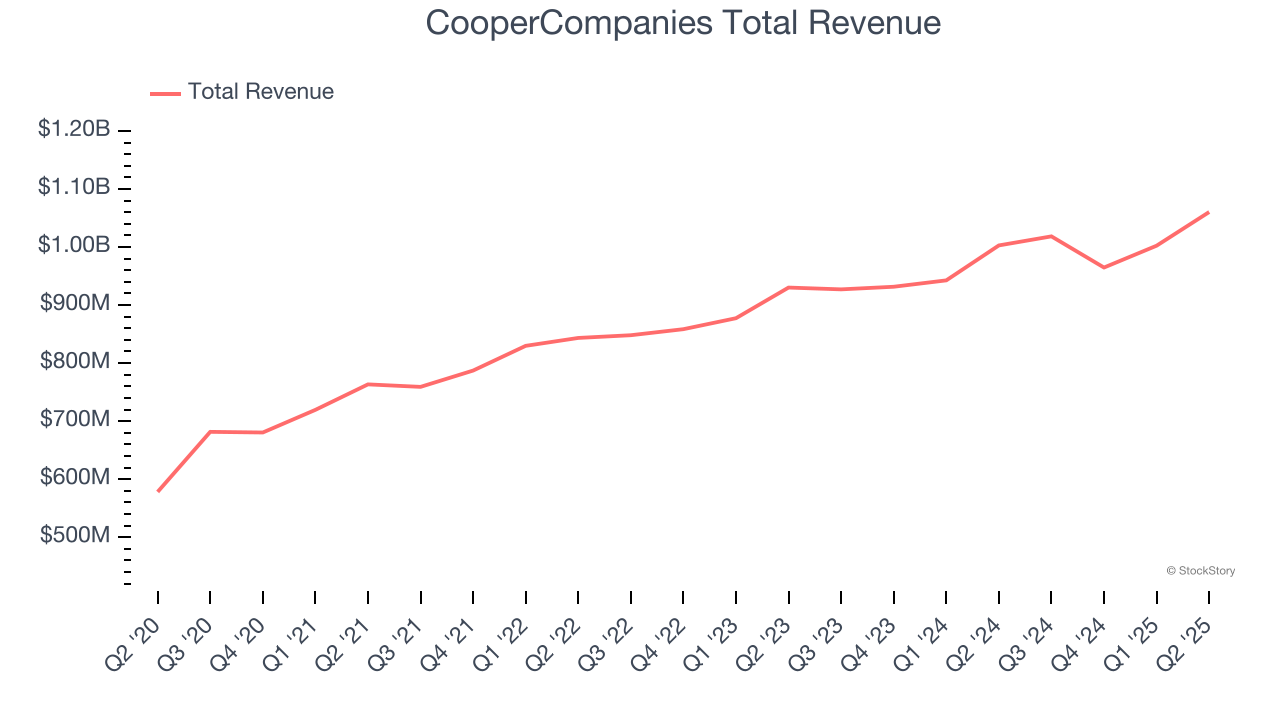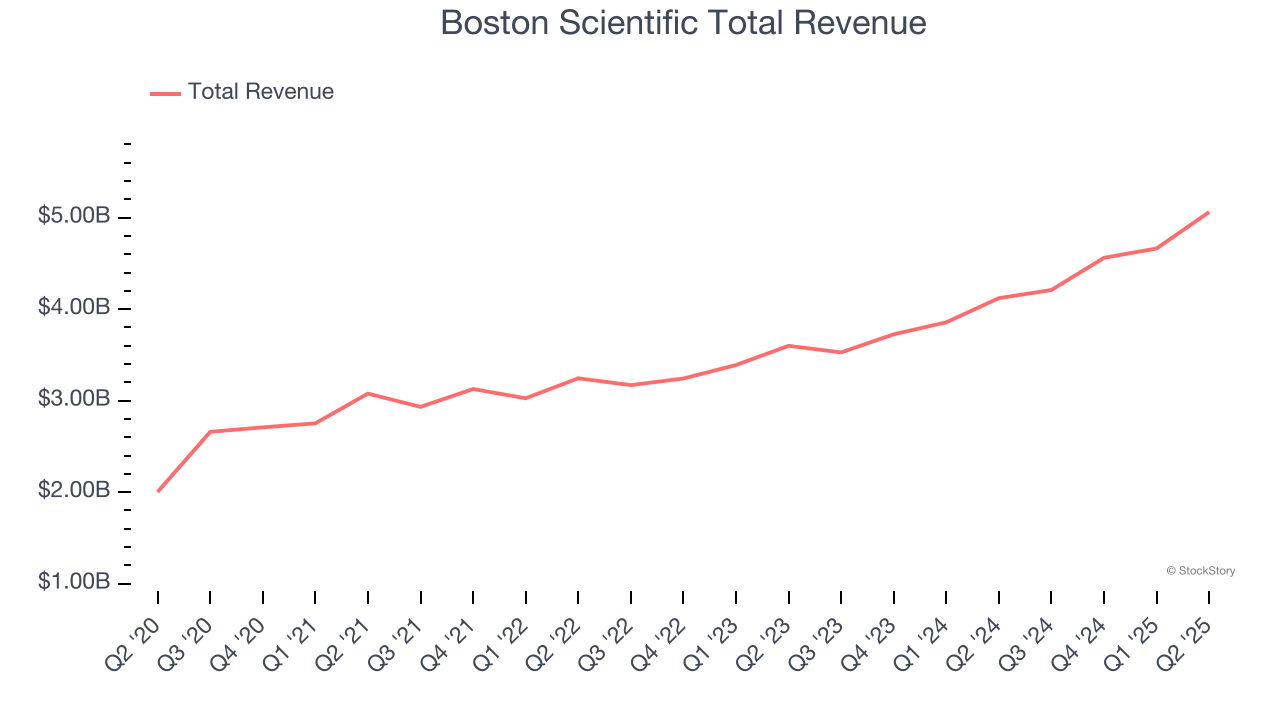
Looking back on medical devices & supplies - diversified stocks’ Q2 earnings, we examine this quarter’s best and worst performers, including CooperCompanies (NASDAQ:COO) and its peers.
The medical devices industry operates a business model that balances steady demand with significant investments in innovation and regulatory compliance. The industry benefits from recurring revenue streams tied to consumables, maintenance services, and incremental upgrades to the latest technologies. However, the capital-intensive nature of product development, coupled with lengthy regulatory pathways and the need for clinical validation, can weigh on profitability and timelines. In addition, there are constant pricing pressures from healthcare systems and insurers maximizing cost efficiency. Over the next several years, one tailwind is demographic–aging populations means rising chronic disease rates that drive greater demand for medical interventions and monitoring solutions. Advances in digital health, such as remote patient monitoring and smart devices, are also expected to unlock new demand by shortening upgrade cycles. On the other hand, the industry faces headwinds from pricing and reimbursement pressures as healthcare providers increasingly adopt value-based care models. Additionally, the integration of cybersecurity for connected devices adds further risk and complexity for device manufacturers.
The 6 medical devices & supplies - diversified stocks we track reported a mixed Q2. As a group, revenues beat analysts’ consensus estimates by 1.1% while next quarter’s revenue guidance was in line.
While some medical devices & supplies - diversified stocks have fared somewhat better than others, they have collectively declined. On average, share prices are down 2% since the latest earnings results.
CooperCompanies (NASDAQ:COO)
With a history dating back to 1958 and a portfolio spanning two distinct healthcare segments, Cooper Companies (NASDAQ:COO) develops and manufactures medical devices focused on vision care through contact lenses and women's health including fertility products and services.
CooperCompanies reported revenues of $1.06 billion, up 5.7% year on year. This print was in line with analysts’ expectations, but overall, it was a slower quarter for the company with a miss of analysts’ organic revenue estimates and revenue guidance for next quarter meeting analysts’ expectations.
Commenting on the results, Al White, CooperCompanies' President and CEO said, "I am pleased to report that we delivered strong margins, double-digit earnings growth, and robust free cash flow reflecting the operational excellence that remains central to our growth strategy. Our revenues were below expectations but we're raising earnings guidance to reflect our operational performance and expect improving revenue in Q4 and in fiscal 2026 driven by MyDAY®. We remain confident in our strategy and ability to deliver long-term shareholder value."

CooperCompanies delivered the weakest full-year guidance update of the whole group. Unsurprisingly, the stock is down 9.2% since reporting and currently trades at $67.32.
Read our full report on CooperCompanies here, it’s free.
Best Q2: Boston Scientific (NYSE:BSX)
Founded in 1979 with a mission to advance less-invasive medicine, Boston Scientific (NYSE:BSX) develops and manufactures medical devices used in minimally invasive procedures across cardiovascular, urological, neurological, and gastrointestinal specialties.
Boston Scientific reported revenues of $5.06 billion, up 22.8% year on year, outperforming analysts’ expectations by 3.4%. The business had a very strong quarter with an impressive beat of analysts’ organic revenue estimates and a decent beat of analysts’ full-year EPS guidance estimates.

Boston Scientific pulled off the biggest analyst estimates beat and fastest revenue growth among its peers. The market seems content with the results as the stock is up 2.5% since reporting. It currently trades at $105.75.
Is now the time to buy Boston Scientific? Access our full analysis of the earnings results here, it’s free.
Weakest Q2: Baxter (NYSE:BAX)
With a history dating back to 1931 and products used in over 100 countries, Baxter International (NYSE:BAX) provides essential healthcare products including dialysis therapies, IV solutions, infusion systems, surgical products, and patient monitoring technologies to hospitals and clinics worldwide.
Baxter reported revenues of $2.81 billion, up 4.3% year on year, in line with analysts’ expectations. It was a softer quarter as it posted a significant miss of analysts’ EPS estimates and a miss of analysts’ full-year EPS guidance estimates.
Baxter delivered the weakest performance against analyst estimates in the group. As expected, the stock is down 12% since the results and currently trades at $24.69.
Read our full analysis of Baxter’s results here.
Neogen (NASDAQ:NEOG)
Founded in 1981 and operating at the intersection of food safety and animal health, Neogen (NASDAQ:NEOG) develops and manufactures diagnostic tests and related products to detect dangerous substances in food and pharmaceuticals for animal health.
Neogen reported revenues of $225.5 million, down 4.8% year on year. This result topped analysts’ expectations by 1.3%. Overall, it was a strong quarter as it also put up full-year revenue guidance exceeding analysts’ expectations and full-year EBITDA guidance topping analysts’ expectations.
Neogen achieved the highest full-year guidance raise but had the slowest revenue growth among its peers. The stock is up 7.1% since reporting and currently trades at $5.81.
Read our full, actionable report on Neogen here, it’s free.
Stryker (NYSE:SYK)
With over 150 million patients impacted annually through its innovative healthcare technologies, Stryker (NYSE:SYK) develops and manufactures advanced medical devices and equipment across orthopedics, surgical tools, neurotechnology, and patient care solutions.
Stryker reported revenues of $6.02 billion, up 11.1% year on year. This number surpassed analysts’ expectations by 1.6%. It was a strong quarter as it also logged an impressive beat of analysts’ organic revenue estimates and a narrow beat of analysts’ full-year EPS guidance estimates.
The stock is flat since reporting and currently trades at $391.41.
Read our full, actionable report on Stryker here, it’s free.
Market Update
In response to the Fed’s rate hikes in 2022 and 2023, inflation has been gradually trending down from its post-pandemic peak, trending closer to the Fed’s 2% target. Despite higher borrowing costs, the economy has avoided flashing recessionary signals. This is the much-desired soft landing that many investors hoped for. The recent rate cuts (0.5% in September and 0.25% in November 2024) have bolstered the stock market, making 2024 a strong year for equities. Donald Trump’s presidential win in November sparked additional market gains, sending indices to record highs in the days following his victory. However, debates continue over possible tariffs and corporate tax adjustments, raising questions about economic stability in 2025.
Want to invest in winners with rock-solid fundamentals? Check out our Top 6 Stocks and add them to your watchlist. These companies are poised for growth regardless of the political or macroeconomic climate.
StockStory is growing and hiring equity analyst and marketing roles. Are you a 0 to 1 builder passionate about the markets and AI? See the open roles here.
